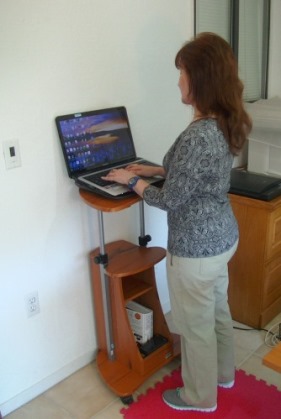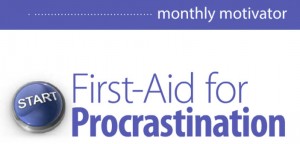 Does your stomach ever get queasy right before a big writing deadline or a meeting with an important client?
Does your stomach ever get queasy right before a big writing deadline or a meeting with an important client?
You know what I mean… that churning, worse-than-butterflies-in-your-gut feeling?
So, what do you do? Reach for an antacid? Practice deep breathing? Maybe lie down for a few minutes?
Well, apparently “writer’s dyspepsia” has been a well-known ailment among writers for some time. In the July 1883 edition of Popular Science Monthly, Felix L. Oswald, M.D., suggested the following remedy:
” …At the first symptoms of indigestion, bookkeepers, entry-clerks, authors, and editors should at once get a telescope-desk. Literary occupations need not necessarily involve sedentary habits… Schreber’s telescope-desk enables the writer to sit and stand by turns, and has the further advantage of a sloping top that eases the wrist by resting the weight of the arm upon the elbow.”
In 1883, what Dr. Oswald called a “telescope-desk” is known today as a standing or stand-up desk.
It occurred to me a few years ago that I might want to give writing while standing a try. While not a sufferer of “writer’s dyspepsia,” I was definitely experiencing back and neck aches after long hours of sitting at my computer.
I remembered reading that Ernest Hemingway and Winston Churchill used standing desks. This tidbit of information spurred my quest to discover whether or not standing desks are better for your health as a writer.
The Scientist and His “Magic Underwear” Experiment
One article on the topic that fascinated me was on Dr. James Levine, a Mayo Clinic researcher who specializes in inactivity studies. In 2005, Dr. Levine outfitted test subjects with skintight shorts that had sensors attached to the thighs and wires leading to a portable data-collecting device.
These motion-tracking shorts (dubbed “magic underwear” by The New York Times reporter who covered the story) measured every movement — twice a second, 24-hours a day — that participants made as they went about their daily activities. The shorts tracked an amazing amount of data, including the amount of time subjects spent lying, standing, walking, or sitting.
Dr. Levine’s findings turned common perceptions about activity and health upside down.
He concluded that too much sitting was a dangerous — if not downright lethal — activity. He likened it to the health risks associated with cigarette smoking.
According to Dr. Levine, too much sitting decreases the electrical activity in the muscles and increases the risk of developing Type 2 diabetes. It increases the risk of obesity and developing heart disease.
One 13-year study of 17,000 participants found that people who spend most of their day sitting are 54% more likely to die of heart attacks.
And lest you think you can undo a day’s worth of sitting by hitting the gym after work, think again. According to both Dr. Levine and researchers at the American Cancer Society, the health benefits of daily exercise are not enough to counteract the damage done from sitting all day.
“Yikes!” I thought after reading the research. “So, what’s a writer to do whose job requires her to spend long stretches of time sitting on her keister pounding out copy?”
Well, according to Dr. Levine, the key is to break up periods of sitting with activity. It’s the hours of uninterrupted sitting that play havoc with our bodies and overall good health.
Dr. Levine’s simple solution? Move more at work and get up for 10 minutes every hour.
How I Became a “Stand Up” Kind of Gal…
Dr. Levine’s study convinced me. As part of my 2015 New Year’s Resolution, I purchased a standing desk and resolved to be more active during my workday.
Here’s what I’ve learned over that year:
1. There’s a surprising number of standing desk options on the market
They range in price from $60 for a mobile, height-adjustable laptop cart (which is what I use and love) all the way to $1,500 for a treadmill desk.
Yes, that’s right, it’s a desk attached to a walking treadmill so you can surf the web, write your copy, and exercise all at the same time. Talk about multitasking!
If you don’t want to give up your current desk, or you’re tight on space and don’t have room for an additional piece of furniture, there are kits that will convert your current desk to a standing desk. These range from $100 to $200.
If you’re looking for a motorized desk that will allow you to go from sitting to standing at the press of a button, you might be interested in IKEA’s Bekant desk (starting at $489).
One caveat: You can get most of these options online, but you’ll probably need to do some assembly. A friend and I assembled my standing desk in a couple of hours.
2. Alternating between standing and sitting works best for me
Initially, in my zeal to perfect my new standing-while-working routine, I overdid it. I put in way too many hours of uninterrupted standing. My productivity plummeted and I ended up with achy feet and legs.
A quick online search pointed me to studies that showed excessive standing has its own set of health risks, including varicose veins and carotid artery disease.
So, moderation seems to be the key when making the sitting-to-standing transition. With the help of good shoes and a standing mat, I can now comfortably stand and write for a few hours at a time. I alternate between standing and sitting throughout the day, listening to my body’s signals to alert me when it’s time for a break.
3. I categorize which work activities I can do standing up
For intense writing projects that require focus, I found I’m more productive sitting down.
However, I found that many of my work activities are easy to do standing up. This includes talking on the phone, responding to email, copy editing, attending webinars, creating client proposals, dictating copy, and doing online research.
I now automatically move my laptop to my standing desk when doing these activities. This easily adds two hours of standing time to my daily routine.
4. I avoid staying frozen in one position for long periods of time
Whether I’m standing or sitting, I found that a lack of movement in any position leads to discomfort. I use an online timer set to 30 minutes to remind me to get up and stretch if I’m sitting, or do a few squats and lunges if I’m standing.
5. I became a fidgeter
Now that I’m conscious about movement and its importance to my good health, I indulge in fun bouts of fidgeting throughout the day. I wiggle my toes. Rock back and forth in my chair. Drum my fingers on my desktop. Bust a quick dance move when nobody’s looking.
Final Thoughts
So, are standing desks better for your health? To sum up, in the year since I started my totally non-scientific, standing-while-working experiment, I’ve dropped 8 lbs … toned my legs and thighs… and have eliminated my back and neck aches.
I have more energy — which means I can take on and complete more writing projects. And, yes, my writing income has increased, too.
Just in case you’re curious… am I standing as I type out these last few words?
You betcha!






